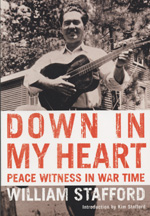
Down in My Heart
William Stafford
Introduction by Kim Stafford
From 1942 to 1946, William Stafford was interned in camps for conscientious objectors after refusing to be inducted into the U.S. Army. As a pacifist, he worked on conservation projects for Civilian Public Service, an alternative program for young men who refused to participate in World War II. As a writer, he recorded the life he found there: the fellowship within the camps and the antagonism outside them.
Down in My Heart tells the story of how a wartime draft created a community for peace. It recounts life in the camps: the men’s day-to-day activities—fighting forest fires, building trails and roads, restoring eroded lands—and their earnest pursuit of a social ethic rooted in religious and secular pacifist ideals. In his introduction to this new edition of the book, Kim Stafford calls them a “generation of seekers,” men who practiced alternatives to violence, refused to augment the killing, and spent the war years working full time to “envision ways to avoid the next war.”
A fascinating look at the formative years of a major American poet, Down in My Heart also provides a rich glimpse into a little-known aspect of the war. First published in 1947, it remains timely, inviting readers to imagine how this legacy of pacifism might inform their own lives.
Of related interest:
Writing the World: Understanding William Stafford Judith Kitchen
Refusing War, Affirming Peace Jeffrey Kovac
Here on the Edge Steve McQuiddy
About the author
William Stafford was born in Kansas in 1914. An enormously loved and admired teacher and poet, he received many honors including the National Book Award for Traveling through the Dark. He taught for thirty years at Lewis & Clark College, and traveled widely as a witness for literature and peace. He died at his home in Lake Oswego, Oregon, in 1993.
Read more about this author
“Down in My Heart is not only Stafford’s first book, but in some ways it is his most important book because it lays out the radical social and moral code by which he lived his life as a pacifist, a code that underlies every poem he ever wrote.” —The Bloomsbury Review

 There are many ways to define a region, yet no single definition can completely capture its essence. The diverse books published by university presses help define and describe the complexity of various regions, covering everything from a region's history, culture, flora and fauna, geography, natural history, ecosystems, watersheds, and political history, to its folklore, literature, and art. They may include reprint editions of out-of-print regional classics, as well as newly written books. Such books are usually written for general readers as well as scholars and students, with an emphasis on good writing and accessibility, and published in attractively designed, well-illustrated editions. Increasingly, such books are available electronically—some with digital ancillaries—as well as in print.
There are many ways to define a region, yet no single definition can completely capture its essence. The diverse books published by university presses help define and describe the complexity of various regions, covering everything from a region's history, culture, flora and fauna, geography, natural history, ecosystems, watersheds, and political history, to its folklore, literature, and art. They may include reprint editions of out-of-print regional classics, as well as newly written books. Such books are usually written for general readers as well as scholars and students, with an emphasis on good writing and accessibility, and published in attractively designed, well-illustrated editions. Increasingly, such books are available electronically—some with digital ancillaries—as well as in print.